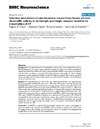Please use this identifier to cite or link to this item:
https://accedacris.ulpgc.es/handle/10553/44423
| DC Field | Value | Language |
|---|---|---|
| dc.contributor.author | Tomé, Ângelo R. | en_US |
| dc.contributor.author | Castro López-Tarruella, Enrique | en_US |
| dc.contributor.author | Santos, Rosa M. | en_US |
| dc.contributor.author | Rosário, Luís M. | en_US |
| dc.date.accessioned | 2018-11-21T22:57:10Z | - |
| dc.date.available | 2018-11-21T22:57:10Z | - |
| dc.date.issued | 2007 | en_US |
| dc.identifier.issn | 1471-2202 | en_US |
| dc.identifier.other | WoS | - |
| dc.identifier.other | Scopus | - |
| dc.identifier.uri | https://accedacris.ulpgc.es/handle/10553/44423 | - |
| dc.description.abstract | Background: 2-Methylthioadenosine 5 '- triphosphate (2-MeSATP), formerly regarded as a specific P2Y (metabotropic) purinergic receptor agonist, stimulates Ca2+ influx and evokes catecholamine release from adrenal chromaffin cells. These cells express P2Y and P2X ( ionotropic) purinoceptors, with the latter providing an important Ca2+ influx pathway. Using single cell calcium imaging techniques, we have determined whether 2-MeSATP might be a specific P2X receptor agonist in bovine chromaffin cells and assessed the relative role of P2X and P2Y receptors on catecholamine secretion from these cells.Results: ATP raised the [Ca2+](i) in similar to 50% of the cells. Removing extracellular Ca2+ suppressed the [Ca2+](i)-raising ability of 2-MeSATP, observed in similar to 40% of the ATP-sensitive cells. This indicates that 2-MeSATP behaves as a specific ionotropic purinoceptor agonist in bovine chromaffin cells. The 2-MeSATP-induced [Ca2+](i)-rises were suppressed by PPADS. UTP raised the [Ca2+](i) in similar to 40% of the ATP-sensitive cells, indicating that these expressed Ca2+-mobilizing P2Y receptors. UTP-sensitive receptors may not be the only P2Y receptors present, as suggested by the observation that similar to 20% of the ATP-sensitive pool did not respond to either 2-MeSATP or UTP. The average sizes of the ATP- and 2-MeSATP-evoked [Ca2+](i) responses were identical in UTP-insensitive cells. 2-MeSATP stimulated Ca2+ influx and evoked catecholamine release, whereas UTP elicited Ca2+ release from intracellular stores but did not evoke secretion. 2-MeSATP-induced secretion was strongly inhibited by Cd2+ and suppressed by extracellular Ca2+ or Na+ removal. TTX inhibited 2-MeSATP-evoked secretion by similar to 20%.Conclusion: 2-MeSATP is a specific P2X purinoceptor agonist and a potent secretagogue in bovine chromaffin cells. Activation of 2-MeSATP-sensitive receptors stimulates Ca2+ influx mainly via voltage-sensitive Ca2+ channels. For the most part, these are activated by the depolarization brought about by Na+ influx across P2X receptor pores. | en_US |
| dc.language | eng | en_US |
| dc.relation.ispartof | BMC Neuroscience | en_US |
| dc.source | BMC Neuroscience [ISSN 1471-2202], v. 8, Article number 41, (Junio 2007) | en_US |
| dc.subject | 230207 Química clínica | en_US |
| dc.subject | 320502 Endocrinología | en_US |
| dc.subject | 2403 Bioquímica | en_US |
| dc.subject.other | Chromaffin cell | en_US |
| dc.subject.other | Suramin | en_US |
| dc.subject.other | Catecholamine secretion | en_US |
| dc.subject.other | Adrenal chromaffin cell | en_US |
| dc.subject.other | Bovine chromaffin cell | en_US |
| dc.title | Selective stimulation of catecholamine release from bovine adrenal chromaffin cells by an ionotropic purinergic receptor sensitive to 2-methylthio ATP | en_US |
| dc.type | info:eu-repo/semantics/article | en_US |
| dc.type | Article | en_US |
| dc.identifier.doi | 10.1186/1471-2202-8-41 | en_US |
| dc.identifier.scopus | 2-s2.0-34447251652 | - |
| dc.identifier.scopus | 34447251652 | - |
| dc.identifier.isi | 000247988600001 | - |
| dc.contributor.authorscopusid | 7006456425 | - |
| dc.contributor.authorscopusid | 35095882100 | - |
| dc.contributor.authorscopusid | 7201375211 | - |
| dc.contributor.authorscopusid | 7006255537 | - |
| dc.contributor.authorscopusid | 57210845913 | - |
| dc.identifier.eissn | 1471-2202 | - |
| dc.identifier.issue | 41 | - |
| dc.relation.volume | 8 | en_US |
| dc.investigacion | Ciencias de la Salud | en_US |
| dc.type2 | Artículo | en_US |
| dc.contributor.daisngid | 608684 | - |
| dc.contributor.daisngid | 1646925 | - |
| dc.contributor.daisngid | 1578132 | - |
| dc.contributor.daisngid | 780852 | - |
| dc.description.numberofpages | 7 | en_US |
| dc.utils.revision | Sí | en_US |
| dc.contributor.wosstandard | WOS:Tome, AR | - |
| dc.contributor.wosstandard | WOS:Castro, E | - |
| dc.contributor.wosstandard | WOS:Santos, RM | - |
| dc.contributor.wosstandard | WOS:Rosario, LM | - |
| dc.date.coverdate | Junio 2007 | en_US |
| dc.identifier.ulpgc | Sí | es |
| dc.description.jcr | 2,987 | |
| dc.description.jcrq | Q2 | |
| dc.description.scie | SCIE | |
| item.grantfulltext | open | - |
| item.fulltext | Con texto completo | - |
| crisitem.author.dept | Departamento de Bioquímica y Biología Molecular, Fisiología, Genética e Inmunología | - |
| crisitem.author.fullName | Castro López-Tarruella, Enrique | - |
| Appears in Collections: | Artículos | |
SCOPUSTM
Citations
9
checked on Jun 8, 2025
WEB OF SCIENCETM
Citations
6
checked on Jun 8, 2025
Page view(s)
92
checked on Mar 9, 2024
Download(s)
82
checked on Mar 9, 2024
Google ScholarTM
Check
Altmetric
Share
Export metadata
Items in accedaCRIS are protected by copyright, with all rights reserved, unless otherwise indicated.
